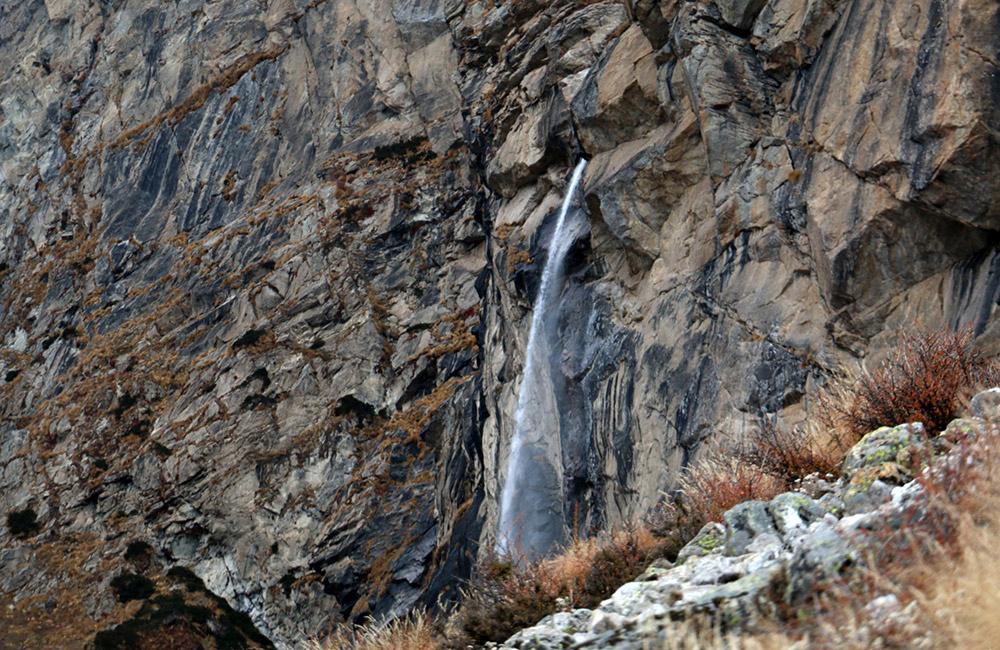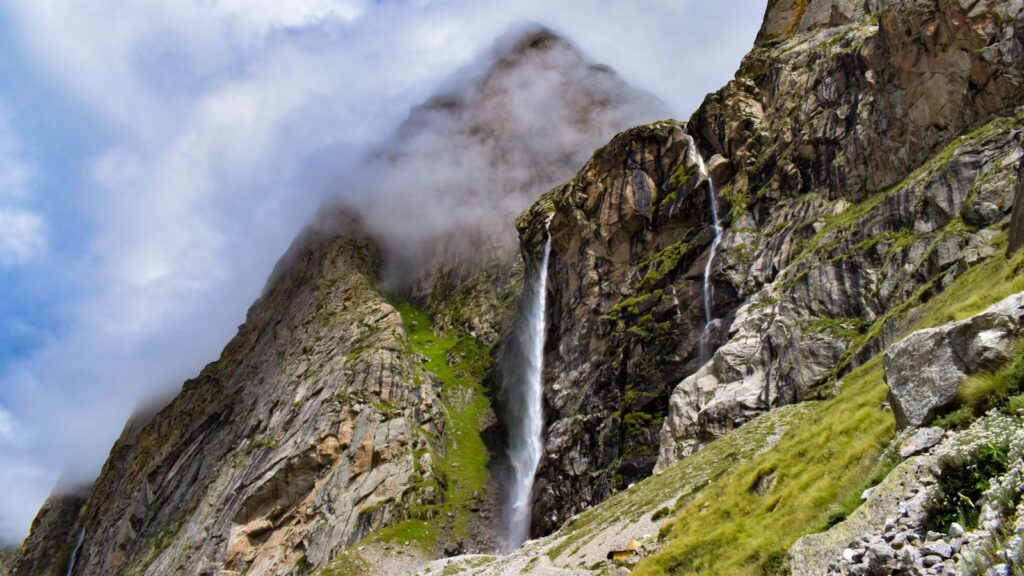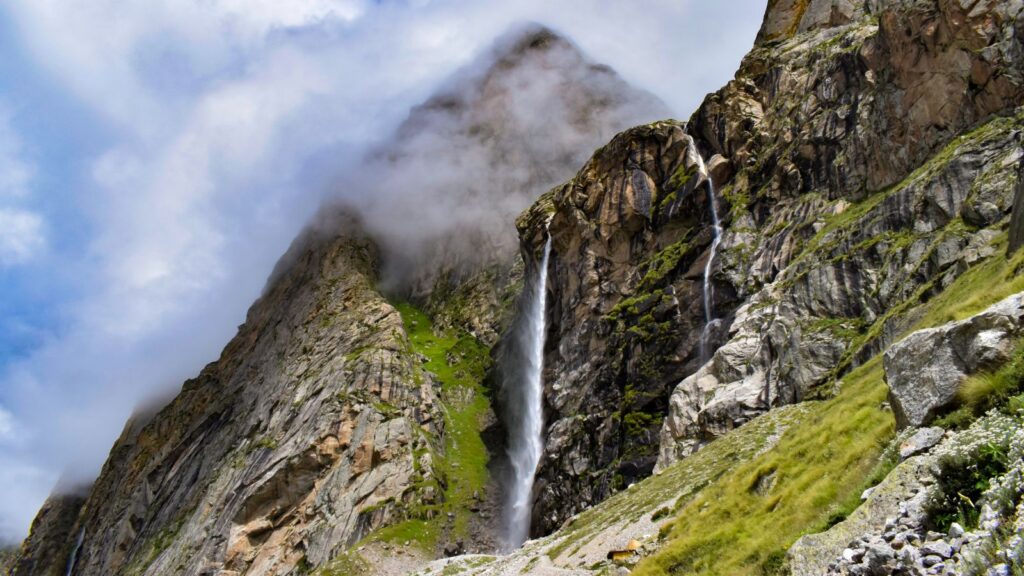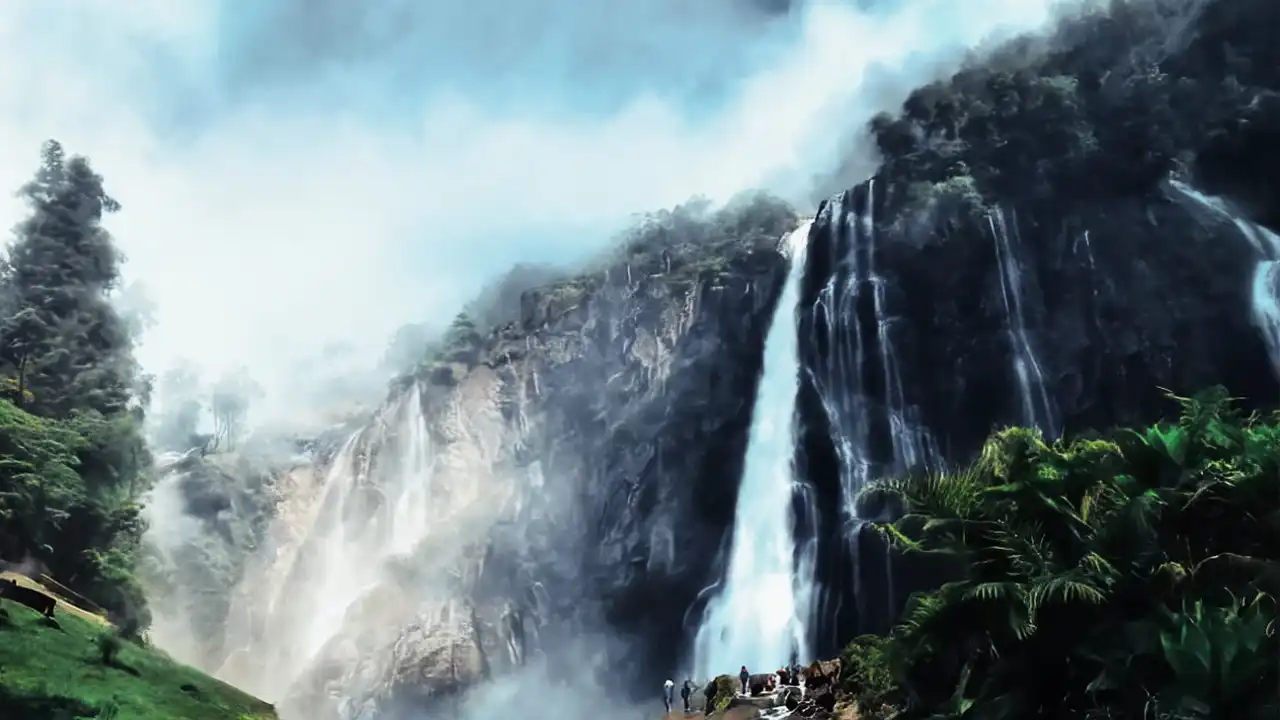Nestled in the high Himalayas of Uttarakhand, Vasudhara Falls is one of the most stunning and spiritually significant waterfalls in the Garhwal region. Located about 6 kilometers from Mana Village and roughly 14 kilometers from Badrinath, this spectacular waterfall cascades down from an approximate height of 145 meters, creating a breathtaking spectacle amid pristine Himalayan landscapes.
Unlike crowded tourist spots, Vasudhara Falls offers a serene escape where the roar of the falling water blends with the silence of towering peaks, alpine meadows, and rhododendron forests. It is not just a natural marvel but also a place of mythological importance, attracting pilgrims, trekkers, and nature enthusiasts alike of Vasudhara Falls Uttarakhand.

Mythological Significance
Vasudhara Falls holds a deep connection with Hindu mythology and the Mahabharata. The name “Vasudhara” means “the one that holds the Earth” and is often associated with divine blessings and purification.
Local legends suggest that the waterfall was a site where Pandavas passed during their exile, and it is said that Bhima performed rituals and prayers near this waterfall. The waters are believed to have healing properties, and many pilgrims consider a dip in the icy waters as spiritually purifying before continuing their journey to Badrinath or Mana Village.
Another belief connects Vasudhara Falls with Lord Vishnu, as the area around Badrinath is considered sacred to him. Pilgrims often stop at the falls to meditate, offer prayers, or simply reflect on the magnificence of nature.

Location and Accessibility
- Distance from Badrinath: 14 km
- Distance from Mana Village: 6 km
- Altitude: Approximately 3,500 meters (11,500 feet)
The waterfall is located in a remote, high-altitude setting, surrounded by snow-capped peaks, glaciers, and alpine meadows. The area is accessible via trekking trails that offer breathtaking views of the Himalayas, lush green valleys, and seasonal flora.
Trekking to Vasudhara Falls
The journey to Vasudhara Falls is an adventure in itself, combining natural beauty, moderate trekking, and spiritual reflection.
Trek Details:
- Starting Point: Mana Village
- Distance: About 6 kilometers one way
- Duration: 2–3 hours depending on pace
- Difficulty Level: Moderate (suitable for regular trekkers)
The trek is mostly uphill, with trails running alongside glacial streams and alpine meadows. Pilgrims and trekkers pass through patches of rhododendrons, moss-covered rocks, and seasonal wildflowers, creating a vibrant and scenic path.

Natural Beauty of the Waterfall
Vasudhara Falls is renowned for its sheer vertical drop, creating a misty veil that shimmers in the sunlight. The water collects in a pristine pool at the base, surrounded by rocky terrain and alpine flora. The surrounding peaks add a dramatic backdrop, making it a favorite spot for photographers and nature lovers.
In summer, the waterfall is in full flow, fed by glacial melt, while in winter, it partially freezes, creating an ethereal icy cascade that seems straight out of a Himalayan painting.
Flora and Fauna
The region around Vasudhara Falls supports a rich variety of high-altitude flora and fauna:
- Flora: Rhododendrons, blue poppies, alpine grasses, and Brahma Kamal (a sacred Himalayan flower).
- Fauna: Himalayan monals, snow pigeons, marmots, and occasional sightings of Himalayan tahr and musk deer.
The lush greenery and vibrant blooms make the trek visually rewarding, especially during spring and summer.

Spiritual Experience
Vasudhara Falls is more than a visual spectacle; it is a spiritual retreat. Pilgrims often meditate near the waterfall, listen to the soothing roar of the cascading waters, and perform rituals that have been part of Himalayan tradition for centuries.
The icy water symbolizes purification and devotion, and spending time here is believed to calm the mind, refresh the spirit, and deepen one’s connection with nature and divinity.
Nearby Attractions
While visiting Vasudhara Falls, travelers can explore nearby landmarks:
- Mana Village – The last Indian village before the Indo-Tibetan border, known for Bhima’s Cave and traditional Himalayan lifestyle.
- Badrinath Temple – A sacred Char Dham site, about 14 km away, offering spiritual fulfillment and historical significance.
- Satopanth Lake – A high-altitude glacial lake accessible via a longer trek from Mana Village, offering panoramic Himalayan views.
- Bhima Pul – A natural rock formation associated with Mahabharata legends, located near Mana Village.
These destinations complement the experience of visiting Vasudhara Falls, blending adventure, spirituality, and nature.
Best Time to Visit
The ideal time to visit Vasudhara Falls is May to October:
- Summer (May–June): Snow begins to melt, trails are clear, and the waterfall is in full flow.
- Autumn (September–October): Crisp air, clear skies, and fewer crowds make the visit peaceful and picturesque.
Monsoon season (July–August) is not recommended due to slippery trails and the risk of landslides. Winter months are largely inaccessible due to heavy snowfall.
Tips for Visitors
- Wear trekking shoes with good grip for rocky trails.
- Carry warm clothing as temperatures can drop suddenly.
- Pack water and snacks, especially for the uphill trek.
- Hire a local guide if unfamiliar with the terrain.
- Respect nature – Do not litter and avoid disturbing wildlife.
- Start early in the day to enjoy the waterfall and return safely before sunset.
Why Vasudhara Falls is Special
Vasudhara Falls combines natural grandeur, mythological importance, and spiritual essence:
- Its sheer vertical drop and glacial waters make it a visual marvel.
- The association with Pandavas and local legends adds cultural depth.
- Its remote, tranquil setting offers an escape from crowded pilgrimage spots.
- The surrounding trails and meadows allow for trekking, photography, and meditation.
It is a destination that satisfies adventurers, pilgrims, and nature enthusiasts alike.
Conclusion
Vasudhara Falls is a testament to the Himalayas’ power, beauty, and spirituality. The roar of cascading waters, the pristine alpine surroundings, and the myths that accompany the place create a magical experience.
For pilgrims visiting Badrinath or Mana Village, a trek to Vasudhara Falls is not merely an excursion but a spiritual and natural journey. It is a place where one can reflect, meditate, and connect with the untouched splendor of the Himalayas, leaving an indelible mark on the heart and soul.
FAQs for Vasudhara Falls
- Where is Vasudhara Falls located?
Vasudhara Falls is located about 6 km from Badrinath Temple in Chamoli district, Uttarakhand. - Why is Vasudhara Falls famous?
It is famous for its breathtaking waterfall, trekking route, and serene Himalayan surroundings. - What is the height of Vasudhara Falls?
The waterfall plunges approximately 145 meters (475 feet) from the mountainside. - How far is the trek to Vasudhara Falls?
The trek from Badrinath to Vasudhara Falls is about 6 km uphill, taking 2–3 hours. - Is the trek to Vasudhara Falls difficult?
The trek is moderate and suitable for beginners and pilgrims with good stamina. - What is the best time to visit Vasudhara Falls?
May to October is ideal, avoiding heavy snowfall and monsoon-related landslides. - Are there camping facilities near Vasudhara Falls?
Yes, trekkers can camp near the falls with proper gear and permissions. - Is Vasudhara Falls part of the Char Dham Yatra?
It is not a Char Dham site, but it is a popular excursion for pilgrims visiting Badrinath. - What wildlife can be seen near Vasudhara Falls?
Himalayan birds, mountain goats, and occasional sightings of wildflowers and butterflies are common. - How to reach Vasudhara Falls from Badrinath?
Trek from Badrinath town via a marked trail; the nearest road-accessible point is Badrinath itself.


